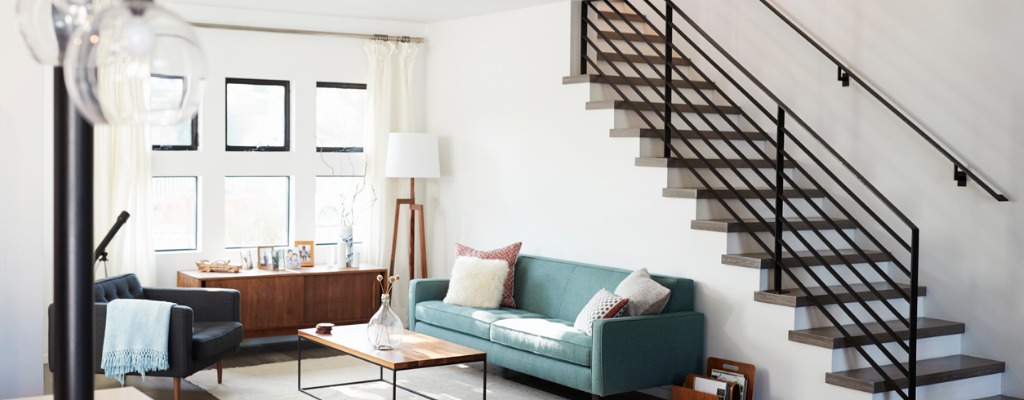Even if you have central air and heating, things will feel different around your home when winter arrives. If you live in a multi-level home, you could find that the basement feels colder than the upstairs. What gives?
It’s not your imagination or your mind playing tricks on you. In the winter (and in the summer) the temperature can change when you walk up the stairs. There’s a good explanation for why this is happening, and there are a few things you can do to make the temperature feel more even throughout your home. Plus, it could improve the energy efficiency of your HVAC system.
The Simple Explanation for Why It’s Hot Upstairs and Cold Downstairs
You may remember from science class that the temperature of the air affects its density, or how much it weighs.
So, why is it warmer upstairs than downstairs?
Cold air is denser than warm air, so it stays on the bottom while warm air rises. That’s why the downstairs can feel so chilly while the upstairs is toasty in the winter. The temperature differential between the upstairs and downstairs in an average two-story home is between 8 to 10 degrees.
This matter of physics is the same reason why homes in the south were built with tall ceilings before air conditioning existed. The warm air rising to the ceiling makes it more comfortable in the summer.
But that may not be the end of the story. There could be a few other contributing factors that are making temperature control more challenging. The difference in upstairs and downstairs temperature can be more pronounced if:
- There are air leaks in the ductwork.
- The air circulation isn’t efficient.
- The ductwork is imbalanced.
- The vents and/or ductwork aren’t the appropriate size.
The issue is usually both manmade and naturally occurring. If you notice that there are temperature variations on the same level, then there’s a good chance something is off in the HVAC system.
Do you wish to change your home for the better? Verde Energy provides dependable electricity to keep your home at a pleasant temperature throughout the year, especially in the winter. Our fixed-rate green energy programs are available to clients across the United States. Go here to register.
How to Make the Temperature More Balanced on Both Floors
If you’re wondering, how do you keep a two-story house warm, in the winter?
The conventional general guideline is to set each thermometer two degrees Fahrenheit apart from each other. Set the top floor to the exact temperature you want in your home. Then set the floor thermostat two degrees warmer.
If you’re experiencing imbalanced temperatures between the upstairs and the downstairs you don’t have to live with it until spring brings warmer weather. There are some easy solutions that could provide a significant improvement to more than the temperature difference.
First, Schedule HVAC Maintenance
You need to know if the temperature difference is strictly Mother Nature or if there’s something more going on. An HVAC technician can check all aspects of your system, including the ductwork, to provide guidance on what measures can be taken to alleviate the problem. Annual maintenance is also a good idea because it keeps your HVAC system running as efficiently as possible.
Make Sure the Air Filters Are Appropriate
Some filters are great at purifying the air, but they aren’t so beneficial in terms of airflow. HVAC air filters and register air filters can dramatically reduce airflow to the point that it creates temperature regulation issues. If you don’t swap the filters out for an option with a lower MERV rating eventually the restricted airflow will damage your HVAC equipment.
Replace Your Air Filters
Airflow can still become an issue even if the air filters are appropriate if you don’t replace or clean them regularly. Over time air filters become clogged with all the particles they are cleaning out of the air. When that happens airflow will be restricted. You’ll need to clean washable filters every month and replace disposable filters every 1-3 months.
Ductwork Insulation & Repair
If your ducts are accessible, examine your ducts to check whether they’ve been exposed to anything that could have harmed them. Remove and replace any damaged ducts and cover them with insulation to keep the air at the proper temperature. Of course, if you can’t access your ducts without pulling down walls, this becomes extremely difficult and inconvenient, but it may still be worth it to avoid having to purchase new HVAC systems.
Redirect the Airflow With Manual Dampers
Another way to balance out the cold and hot spots is to block or partially block airflow into the rooms that are hot when the heater is running. This can be done with manual dampers at the air vents.
How to solve inconsistent heating and cooling in a two-story home
With your thermostats, divide and conquer. In a two-story home, a multi-zone air conditioning system is usually installed. This allows you to control the temperature on each floor of your home separately, giving you greater control while also conserving energy and money. Room zoning systems allow you to control the temperature on each level of your home independently. These programmable thermostats are set up to work with dampers installed in your ducts. The dampers are programmed to open and close automatically in response to the temperature settings on the thermostats.
What is the best way to deal with temperature differences between floors?
Another tip is to use the fan instead of the “auto” setting. This allows the fan to circulate air around the house while maintaining a steady temperature.
Comprehensive Home Energy Audit
A home energy audit provides a lot of valuable information. It can tell you where there may be gaps in the home’s envelope that are causing problems, if the HVAC system is efficiently designed, and more in addition to telling you how you can save energy by reducing use. An auditor could discover a number of contributing factors you never would have thought to look for. The good news is many of the issues found during a home energy audit are easy to DIY.
Looking for a new energy plan? Want to compare prices to see if you are currently paying a good rate? Interested in green energy?
Verde Energy provides reliable electricity that’s powered by the same natural elements that make the upstairs hotter than downstairs in the winter. Our fixed-rate green energy plans are designed for every type of consumer that wants to offset their carbon footprint.
Use your zip code to find available green energy plans in your area!



